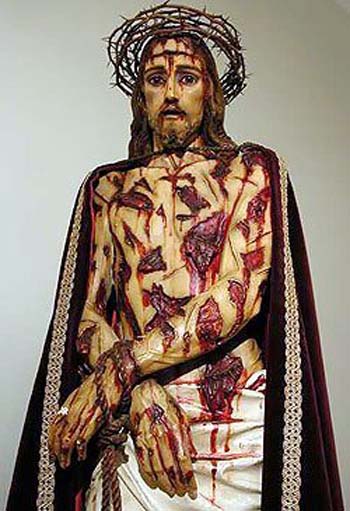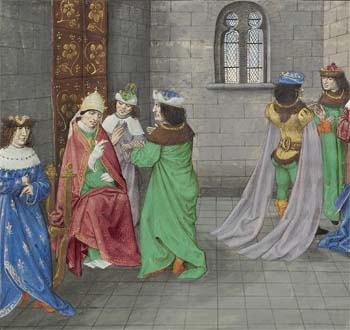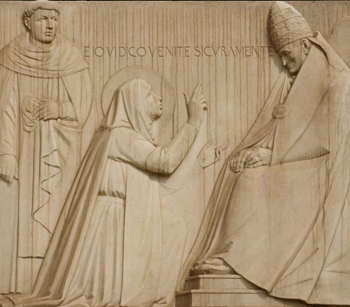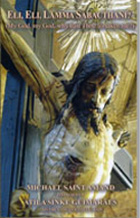About the Church
 |
 |
 |
 |
 |
 |
 |
St. Catherine Sienna Speaks against Bad Clergy – I
‘Eradicate the Wolves inside the Church’
This excerpt on St. Catherine of Siena from Fr. Sáenz’ book titled Christian Archtypes shows how the Saint railed against the bad pastors and Prelates in the Church, counseling that a true reform could only take place when they were eradicated and replaced with good shepherds. The reader can view his Spanish sources at the end of the article.

She condemns priests who are mercenary shepherds and even wolves
Several saints, such as St. Vincent Ferrer and St. Bridget, or even eminent men such as Petrarch, for example, harshly criticized such aberrations. Their message found an echo then among the people, for, as we have said, in that century the population was, despite everything, deeply religious. Then evil did not have, as it does now, a charter of citizenship, giving it an impudence and allowing it to defy the principles of the natural and supernatural order. Those who committed evil accepted the censures that were made against them in the name of Christian morality.
The situation of the Church was something that made Catherine’s heart bleed from a wound that reopened with each new spectacle. What Unamuno said about Spain can well be applied to the Saint: The Church wounded her. In her Dialogue she transcribes some very severe words that God addresses to priests:

‘I suffered My Hands to be tied to free mankind from the bonds of guilt & you use your anointed hands foolishly in dishonest acts’
“Vain and dishonest words come from your mouth, with which you are obliged to admonish your neighbor, announce my word and pray the Office. Yet I perceive from it nothing but stench...
“I suffered My hands to be tied in order to free you, and all mankind, from the bonds of guilt. Yet your hands, anointed and consecrated to administer the Most Holy Sacrament, are used foolishly in dishonest acts... All your members, like cacophonous instruments, transmit a bad sound, because the three faculties of the soul come together in the name of the Devil, when you should gather them in My name...”
Our Lord even goes so far as to compare these bad priests to devils incarnate, because they have identified themselves with the will of the Devil: “They do the same work as he does, with regard to Me...”
St. Catherine warns against the “unworthy ministers of the Blood”: “Because of their defects, the Blood is corrupted, that is, the lay people lose the due reverence they should have for them and for the Blood.”
Catherine fully agrees with these assessments of God. She knows that the holiness of the clergy is closely linked to the beauty of the Bride of Christ and the salvation of souls. “Today we see the opposite,” she affirms in one of her letters. “Not only are they not temples of God, but they have become stables and pens for pigs and other barnyard animals.”
Much of the blame lies with the Bishops who, as God Himself tells her in the Dialogue, “have been more concerned about multiplying the number of priests rather than their virtues.”
The Church persecuted by corrupt & heretical pastors
St. Catherine of Siena points to three sins that most degraded the clergy in her time: lust, avarice and pride. In her opinion, the time had come to call for a reform. What needed to be reformed was certainly not the Bride herself, who will always remain holy and is not diminished or altered by the defects of her ministers, but rather the latter. “The time has come to weep and lament because the Bride of Christ is being persecuted by her perfidious and corrupt members,” she writes in a letter.

She boldly commands the Pope to be rid of the vain & ambitious Prelates surrounding him
“Thus do you see that those who have been placed to be the pillars and upholders of the Holy Church have become her persecutors with the darkness of heresy. This is no time to sleep, but to defeat them with vigilance, sweat and tears, and with sorrowful and loving desires and humble and continual prayer.”
But Catherine is not content with crying, praying and fasting. She will take concrete steps, addressing the Pope directly, since only he has conditions to remedy so great an evil.
In a letter to Gregory XI, she tells him, on behalf of Christ, that he must decide to use his power to remove from the garden of the Church these corrupt flowers, “the bad shepherds and leaders filled with impurity and greed and swollen with pride who poison and putrefy this garden.” He must use his power to remove these persons, putting in their place shepherds according to the heart of God.

She is not content to fast & pray, but believes it necessary to address the Pope face to face & in letters
At times, she continued, these Prelates praise the bad or mediocre candidates because they share their vices and ambitions. When the Pope discovers the truth of the situation, he should remove them. If he does, he will fulfill his duty. If not, he will not go unpunished when he will have to give an account before the Lord of his sheep.
To avoid such drastic measures as the deposition of unworthy Bishops, the Holy Father should choose from the start humble priests, who out of modesty try to avoid prelatures, and not those who seek them to fuel their vainglory. By not acting in this way, we have those Bishops who, as our Saint says to Brother Raymond, “have acted like flies, which are such a base insects that they care not about the sweet and aromatic things upon which they land, but go from there to rest on repugnant and unclean things.”
Continued
Works consulted
* Santa Catalina de Siena, El Diálogo, BAC, Madrid 1955.
* Cartas Políticas, Losada, Buenos Aires 1993.
* Johannes Jörgensen, Santa Catalina de Siena, Acción, Buenos Aires 1993.
* M. V. Bernadot O.P., Santa Catalina de Siena al servicio de la Iglesia, Studium, Madrid 1958.
* Jean Rupp, Docteurs pour nos temps: Catherine et Thérèse, Ed. P. Lethielleux, Paris 1971.
* Jacques Leclercq, Santa Catalina de Siena, Patmos, Madrid 1955.

Posted on September 16,2024














